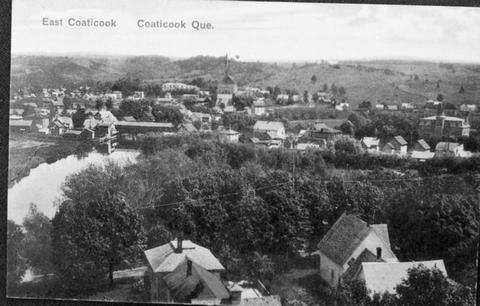The Pioneers (1792-1853)
In 1801, a land grant was given to Lester and Morrogh, merchants, and their associates in the western part of Barnston Township. This request, made in 1792, marks the beginning of the pioneer era in Coaticook. Actually, these men had no intention of settling in the area. They did set up an area of speculation that would last until 1840. In fact, the early settlers of the area were illegals living here--Richard Baldwin, sr., Vester Cleveland and Elisha Thomas. Some of these men would go on to build the first dam on the Coaticook River in 1818.
The land situation became more stable toward the end of the 1830's which helped shape the growth of Coaticook. In 1837, Jonathan Cutting, the most important agricultural owner in the area would acquire the southern part of the town from Main Street on. This area would become known as the Upper Village.
On the other hand, Richard Baldwin, jr., would acquire in 1843, all the northern area, from Main Street to the area around St. Paul Street.
The rest of the lots were sold to William Cleveland in 1845, from the property line belonging to Richard Baldwin, jr., to the top of the North End Hill. This area was known by the name of the Lower Village. The industrial section of the town contained the first mills and the dam built by William and his brother Samuel in 1844.

A merchant from Stanstead, Marcus Child, seized the opportunity to exploit this new marketing area opening up in Coaticook. In 1842, he built the first general store. It should be noted that from the year 1844, he had built a dam on Baldwin Brook, a carding mill and pearl ash factory, an establishment where potash was made from wood ash, followed by a new store on the future Main Street of the future downtown. Around the year 1845, the area known as the Upper Village was became officially known under the name of Child Village, which says a lot about the esteem of this businessman.
The years 1842 to 1845, are therefore considered the cornerstone era in the first development of Coaticook, which was marked by the consistent arrival of many businesses and industries, as well as the development and growth of a residential section.
Crédit : Ville de Coaticook



